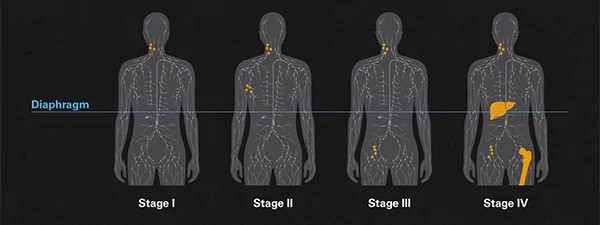At Dana-Farber’s Marginal Zone Lymphoma Center, our team of specialists is committed to delivering advanced, personalized care to patients with marginal zone lymphoma. We are one of a few centers focused on advancing research and offering dedicated clinical trials for patients with this rare condition. Our team creates individualized treatment plans tailored to each patient's unique needs, ensuring the best possible outcomes throughout their journey. Learn more about marginal zone lymphoma and our treatment approach.
Marginal Zone Lymphoma
Why Choose Dana-Farber's Marginal Zone Lymphoma Center
Our team at the Marginal Zone Lymphoma Center has extensive experience and expertise, combining lab and clinical research to better understand this specific lymphoma type and optimize care for patients.
We focus on delivering compassionate, patient-centered care that addresses the specific challenges faced by those with follicular lymphoma. Services include:
- Comprehensive evaluation
- Expert second opinions
- Advanced diagnostics
- Individualized treatment plans offering the latest therapies
- Access to clinical trials offering novel therapies, some exclusively available at Dana-Farber
- Comprehensive supportive care including psychosocial and palliative services
- Access to complementary therapies like nutrition counseling, acupuncture, and massage
- Dedicated follow-up care, including collaboration with your local (referring) physician
What Is Marginal Zone Lymphoma?
Marginal zone lymphoma is a group of rare, slow-growing B-cell non-Hodgkin lymphoma. There are three types of marginal zone lymphoma – extranodal marginal zone lymphoma, nodal marginal zone lymphoma, and splenic marginal zone lymphoma. Approximately 5 to 15 percent of patients with marginal zone lymphoma are at risk for transformation, a process whereby their slow-growing lymphoma turns into an aggressive non-Hodgkin lymphoma, such as diffuse large B-cell lymphoma.
Extranodal Marginal Zone Lymphoma
Extranodal marginal zone lymphoma (also known as mucosa-associated lymphoid tissue or MALT lymphoma) is the most common type of marginal zone lymphoma. It can occur throughout the body, such as in the skin, stomach, thyroid, lungs, bowels, salivary glands, or area around the eyes that can also be sites of concomitant or previous autoimmune of infectious conditions.
Nodal Marginal Zone Lymphoma
Nodal marginal zone lymphoma mostly affects the lymph nodes and can also involve the bone marrow.
Splenic Marginal Zone Lymphoma
Splenic marginal zone lymphoma typically occurs in the spleen, blood, and bone marrow.
What Are Causes and Risk Factors for Marginal Zone Lymphoma?
Common risk factors for all types of marginal zone lymphoma include having:
- Autoimmune conditions
- Chronic infections
- Hepatitis C is a risk factor for nodal and splenic marginal zone lymphoma
- Other infections are risk factors for extranodal marginal zone lymphoma depending on the site of involvement by the lymphoma
- Family history of lymphoma
What Are Marginal Zone Lymphoma Symptoms and Signs?
Because marginal zone lymphoma is a slow-growing condition, some patients may not experience any symptoms. Signs or symptoms vary based on the condition type, but may include:
- Enlarged lymph nodes
- Symptoms related to an enlarged spleen, such as feeling full more quickly than usual when eating a meal
- Symptoms related to the sites of involvement with extranodal marginal zone lymphoma, such as abdominal discomfort in gastric marginal zone lymphoma
How Is Marginal Zone Lymphoma Diagnosed?
The tests used to diagnose marginal zone lymphoma can depend on the type and include:
- Blood tests, including complete blood count and flow cytometry
- Biopsy of lymph node or other suspected involved area
What Are the Stages of Marginal Zone Lymphoma?
Lymphoma staging describes how much the cancer has spread in your body and helps guide treatment decisions. It uses a scale from I to IV, with higher numbers indicating more widespread disease.
- Stage I means cancer is found in only one lymph node area or organ.
- Stage II indicates cancer in two or more lymph node groups, but only on one side of the diaphragm.
- Stage III means the cancer has spread to lymph node regions or structures on both sides of the diaphragm.
- Stage IV indicates that the lymphoma involves organs outside the lymph system including the bone marrow.

How Is Marginal Zone Lymphoma Treated?
Treatment for marginal zone lymphoma depends on a variety of factors, including the subtype, stage of disease, location of disease, and whether a patient has symptoms.
Active Surveillance: How We Monitor and Manage Disease Progression
Because marginal zone lymphoma typically grows slowly many patients do not have symptoms and can be monitored with active surveillance until symptoms develop.
Patients usually meet with their doctor every three to six months with blood tests and physical exam to monitor for disease progression or development of symptoms. If appropriate, our team may offer a clinical trial option that explores treatment to prevent marginal zone lymphoma disease progression.
Treatment for Early-Stage Marginal Zone Lymphoma
Patients with localized or stage I disease often receive radiation treatment. Some patients with gastric marginal zone lymphoma can be treated with antibiotics if their lymphoma is associated with a chronic infection with a bacteria called H. pylori.
Treatment for Advanced Stage Marginal Zone Lymphoma
When patients require treatment for marginal zone lymphoma, treatment varies by subtype and may include:
- A monoclonal antibody, like rituximab
- Chemotherapy and/or immunotherapy
- Targeted drug therapy
- Antibiotics in cases where an infection is suspected that underlies the marginal zone lymphoma
- Radiation
- Clinical trials
